« December 2007 | Main | February 2008 »
January 31, 2008
Pharos Trips & Pics
Here’s a great combo application that has so many possible uses that it is only limited by your imagination. Have you ever wished that you could identify some of those pictures you took years ago and never got around to labeling?
With Pharos Trips & Pics, you can snap away to your heart’s content and the device creates a GPS log and time stamp of your photos so that with supplied software you can pinpoint each shot on Google Maps or Microsoft Streets and Trips.
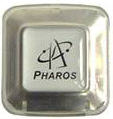 I certainly wish I had this incredible tool was I doing archaeological surveys in jungles, deserts, and mountains around the world. Now I will be content to log photos on my trips and share them with friends and family.
I certainly wish I had this incredible tool was I doing archaeological surveys in jungles, deserts, and mountains around the world. Now I will be content to log photos on my trips and share them with friends and family.
There are many commercial applications possible too that relate to fleet management, law enforcement, surveying, legal work, real estate, conservation, wildlife management, and all kinds of outdoor activities such as hiking, biking, and camping.
The package comes with both hardware and software. You get a CD with the program to install on your computer that integrates the GPS and photo data with a mapping source to plot a trip and pinpoint the location of photos snapped along the way. You also get a iPGS500 receiver, a USB cable, a battery dock, and a charger.
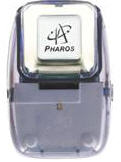 A typical scenario would be that you would charge the battery dock. Connect the receiver to the USB dongle, insert it into your computer to activate it for a trip. Synchronize your camera’s clock with the receiver while connected to the computer. Then remove the receiver from the dongle and insert into the battery pack, which lasts 24 hours between charges. Allow the GPS unit to lock onto the satellites and begin your trip. Every time you take a photo, push the button on the side of the battery pack to record the time and location of the event.
A typical scenario would be that you would charge the battery dock. Connect the receiver to the USB dongle, insert it into your computer to activate it for a trip. Synchronize your camera’s clock with the receiver while connected to the computer. Then remove the receiver from the dongle and insert into the battery pack, which lasts 24 hours between charges. Allow the GPS unit to lock onto the satellites and begin your trip. Every time you take a photo, push the button on the side of the battery pack to record the time and location of the event.
When you get home, connect the receiver to the computer using the dongle again and run the software program to tag the photos so that you can locate them on a map program and share them with others.
What a great little tool, and I do mean little, for the receiver is about an inch square. Coupled with the battery pack, the package measures 1 7/8 x 2 ¾ inches and weighs only slightly over two ounces, so it doesn’t represent much of an extra burden. But don’t let its size deceive you, for it may be small, but it is also a powerful device with myriad uses. I would be fascinated to hear from some of you and the uses to which you put this tool to work.
Of course, you can use this device as a standard GPS receiver if you wish as well.
Sorry, but it won’t be available until next month sometime. Be looking for an announcement. Then you can go to www.pharosgps.com and check it out. I’m not sure how much it will cost, but I’m betting in the hundred dollar range.
Posted by conradb212 at 08:52 PM | Comments (0)
Pharos Drive GPS 250 Navigation System
At the Pharos booth at CES the sleek design of this navigation system attracted me like the A-dog in a litter. It stood out and beckoned to me. I couldn’t wait to receive a review unit, which just arrived, and now I have a couple hundred miles under my road-testing belt.
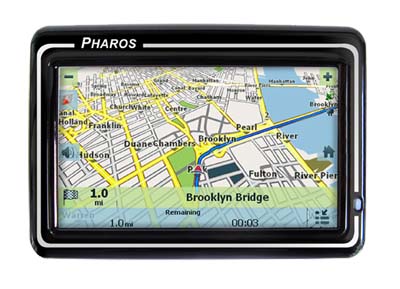
Before reporting my findings, let me give you some of the salient specs and features:
Operating System: Windows CE .net 4.2
CPU: Freescale MX21 266MHz 32bit microprocessor
Internal Memory: SDRAM 64MB, 8 Flash ROM
GPS Receiver:
SiRFstarIII ultra sensitive 20-channel GPS receiver
GPS Frequency: 1575.42 MHz
Acquisition:
Hot start: 8 sec
Warm start: 38 sec
Cold start: 45 sec
Velocity: 0.1 meters/second
Display: 4.3” TFT color screen
Resolution: 480 x 272, 16.7 million colors
Antenna: Built-in internal antenna
Audio: Internal speaker 1W with 3.5mm stereo earphone jack
Power Source: Mini USB connector DC 5.0V/500mAh
Battery:
Rechargeable Li-Polymer battery 1200mAh
Continuous operation time 5~7hrs
Charging time 3~4hrs
Interface:
1 SD/MMC socket
1 Mini USB connector
LED Indication:
Green: Power on mode
Orange: Power on mode and battery is being charged
Red: Power off mode and battery is being charged
LED off: Power off mode and battery is fully charged
Physical Characteristics:
Dimensions: 4.80in (W) x 3.31in (H) x 0.95in (T)
Weight: 0.45lb
Range of Temperatures:
Operating: -20°C ~ 65°C
Storage: -30°C ~ 80°C
Map Data: United States, Canada
Accessories: Travel Bag, Stylus, AC Adapter, Car Charger, Car Mount, USB Cable
Observations
The 250 is easy to use. It acquires a signal in short order, and you are ready to navigate as soon as you set your destination, if you want to be guided. The maps are clear and readable. The navigation prompts pop up helpfully as appropriate. The voice prompts are clear and understandable. There are a number of ways to plot your course that are by now fairly standard on all GPS systems such as recently visited, favorites, coordinates, address, and POIs.
Large, finger friendly keys make it easy to setup, navigate, change views, and input information.
The main map screen displays a set of icons on the left and right margins in obtrusively. On the left top is a minus key for zooming out with a plus on the right to zoom in. Under the minus sign is a compass need that indicates heading, or you can tap on it to change views conveniently to North always up to 3D to 2D. The volume control icon is next down the line.
On the right side, under the plus button, is the satellite icon that shows red when not linked and green when connected. Under that is a battery level indicator. Under that is the QuickNav Settings button that lets you quickly set an address or go to a POI category. This is a very nice feature offered by Pharos on this machine. On the bottom right is the Menu icon that takes you to the main menu with Go!, Map, and Settings Choices. There are appropriate sub-menus from here. The settings buttons allow you to configure the device in many ways. I never could figure out how to change it from 24 hour time, however.
You cannot select voices. So you’d better enjoy the rather pleasant female voice supplied. The satellite information along with speed, altitude, latitude and longitude is in small type and difficult to see, especially when driving. I would like to be able to display some of this information on the main map screen, but that’s not possible.
Tapping anywhere on the map reveals a menu with three handy options (and I really like this): Go there; Add to my favorites, and Set as Starting Point.
The unit snaps firmly and securely into the window mounting device and does not bounce or vibrate.
On the left side of the unit there is a sealed expansion card port that had a label on it warning against breaking the seal and voiding the warranty. This means that you cannot put your own card into the slot to listen to music or watch videos. What a shame.
Under the sealed slot is an 3.5 mm audio output jack. Beneath that is the mini-USB port for charging the unit. On the right side is the power button and reset button. On the upper right corner is the stylus silo.
On the road
This device behaves well on the road. It is easy to program. It locks in quickly. It re-routes very efficiently, which is a huge plus and a big improvement over other models I’ve tested that just give up after a few attempts or if you get too far off track. The visual and audio prompts are clear and easy to understand.
I found the POI database to be lacking in categories and content. It is supposed to contain millions of records, which I’m sure it does, but I have been disappointed repeatedly with it not having many items I would normally expect. It would probably not let you run out of gas, go hungry, or find accommodations, but they may not be the ones you had hoped to locate.
This is a relative and probably minor observation, but it seemed to run rather hot to me, and it was not mounted near a heater vent.
Some surprises
I was truly surprised that this otherwise impressive piece of equipment lacked some features I would expect, features that have been present other Pharos units I’ve tested.
The sealed expansion card slot came as a jolt, for it eliminates the possibilities of listening to tunes, watching videos, and loading other map data.
It surprised me to learn that this unit does not feature Bluetooth. Accordingly, it cannot be used to send and receive phone calls and to act as a hands-free car kit, again a feature present in previous Pharos models. I usually appreciate looking up a POI and then being able to call the location from my Bluetooth connected GPS unit. But that’s not possible with this one unfortunately. Without outside communication, it cannot monitor live traffic conditions and calculate reroutes.
I also wish that I could control more of the items displayed on the map panels. I sometimes like to know my altitude for various reasons as well as my exact compass heading. It would be good to be able to display for destination information too such as arrival time, elapsed time, time until arrival, miles to go, miles traveled, and so forth. I realize it may be difficult to clutter all this information on the screen at once, but it would be nice to be able to toggle it as desired.
One pleasant surprise I discovered is that you can tap on the information bar at the bottom of the screen and som but not all of the data I wished for above toggles into view—nice feature.
Conclusion
This is a handsomely designed unit with a crystal clear viewing screen for navigation with great maps. The navigation prompts, both visual and audio, are excellent and easy to follow. As a navigation tool, it performs well except for the paucity of POIs.
It is disappointing only in the lack of a few features that I pointed out above, but if you are looking for a no-nonsense, efficient navigation device, the Pharos Drive GPS 250 is a good choice.
The suggested retail price is reasonable at $299 and is available at www.pharosgps.com as well as at many online and retail outlets where you may be able to find an even better price.
Posted by conradb212 at 01:51 AM | Comments (0)
January 30, 2008
More from CES
I’m still recovering from the Consumer Electronics Show and could probably write about it for the rest of the year. Let me share with you some of the highlights or at least what caught my attention as noteworthy.
Wi-Fi was everywhere at CES
Decent Wi-Fi access at CES was almost impossible, thanks to the teeming masses of attendees and exhibitors. For this reason, the press room had hardwire connections for the likes of me, which I appreciated greatly.
Wi-Fi was, however, certainly evident in myriad products from HDTVs to digital cameras, game consoles and MP3 players. There was Wireless 1080p HDTV streaming in several booths. I saw oodles of new Wi-Fi-equipped digital photo frames along with a couple Wi-Fi hard drives. D-Link went announced a partnership with SkinIt to wrap its routers in designer skins of your choice for $15 each. Now you can have matching skinned devices, such as your router, laptop, mobile phone, and iPod. Arrggghhh…
New Media Extender
HP unveiled a very interesting new HDTV-capable Media Center Extender box called the MediaSmart Receiver x280N which will cost $300 and be available soon. The MediaSmart X280N works with the Windows Media Center software in Vista Home Premium and Ultimate, as well as certain XP Media Center PCs. This box puts your PC's Media Center interface right on your TV, so you can access movies, TV shows, music, Internet radio stored on your PC or streamed from the Internet. This HP Receiver has an optional removable hard drive for storing media independently of your PC, which puts it ahead of competing extenders lacking this feature. It has an HDMI output for top quality 1080i/720p support and 802.11n Wi-Fi.
More CES show stopper innovations:
- LG Phillips displayed its incredible electric paper which was as flexible as a place mat and looked like a monitor display. The applications here are only limited by the imagination.
- GM exhibited a self-driving car with bazillions of sensors, but it worked pretty well from what I could see in the parking lot.
- SlingMedia’s innovative SlingBox allows you to view, control, and record your home TV remotely anywhere in the world from your laptop or phone. Now you can even record snippets and share them with friends on Websites and in emails.
- Westinghouse exhibited a new Wireless HDTV w/separate audio/video transmitter up to 65 feet away. What a blessing this technology will be for eliminating all those pesky cables.
- Another innovation introduced at the show was a wireless USB hub. I can’t wait for these to become available, so I can reduce the tangle of wires behind my computer.
- Panasonic’s 150 inch plasma HDTV was a real show stopper. It was like a video billboard with brilliant, sharp resolution.
- There were several companies offering video projection glasses with up to 60” screens. I can’t wait to get some to review and start watching movies and my videos and for playing games from my phone.
- Asus announced a 15” and 17” laptop with a huge 1Terrabyte hard drive.
- Digital picture frames that display photos, movies, and recorded sound were everywhere. But the latest ones come with built-in printer and wireless connectivity.
- For the fashion and security conscious, there was a combination MP3 player and taser in a designer holster.
- On the whimsical side Sony rolled out the Rolly which looks something like a colorful potato that rocks and rolls with flashing lights and opening and closing shutters in rhythm to whatever tune you load into it.
- Motorola’s new ROKR EB with no buttons is designed to give the iPhone a run for its money.
- Eye-Fi and Lexar announced a wireless 2 GB SB card, costing $100 that will zap data to computers and Websites wirelessly.
- SanDisk unveiled its new TakeTV, a USB memory stick that transfers video from Internet to TV.
Toshiba is pioneering a new hand gesture technology for controlling for TVs, games, phones, and other devices which eliminates messy fingerprints on video screens.- NoPoPo is a new Japanese battery powered by drop of any liquid, even saliva. It contains no environmentally harmful substances.
- Stay tuned for smarter GPS that will feature two-way communication from satellites and the Internet
- Here’s a cool one for you—the remote control beer cooler for a room full of couch potatoes. You can summon or send it to any guest in the room.
- Sony will soon be offering digital walls with TV, Internet, wallpaper, and game displays.
- Make money with Entropia, a five million dollar treasure hunt with 700,000 active players online.
- I saw an InfraRed motion tracker like a Webcam that lets you interact with computers and play games wirelessly.
- Azentek.com is offering the first car computer with a Vista operating system that costs $2700 and mounts in the dashboard and headrests for passengers in the back seats.
- Skype announced its new conference call feature that allows up to 10 parties to participate over the Internet free. You can even use your mobile phone to participate. Just choose the participants from your contact list and start talking.
I am looking forward in future columns to sharing my experiences with some fun new products from CES as I receive them.
Keep connected
Posted by conradb212 at 12:32 AM | Comments (0)
January 25, 2008
mVisualVoiceMail v.6 -- Stop listening to voice mails
Motion Apps has just released mVisualVoiceMail v.6 a new, improved version for all Windows Mobile devices as well as the Palm OS. This nifty utility grabs incoming voicemails from whatever source and places them in your email inbox. What a great convenience because now you can quickly review all your voicemails and decide on which ones to act on without having to go through the tedious, time-consuming process of listening to all of them, and you have a visual record.
The list displays the caller’s name and number along with the time and date. Of course, in order for the caller’s name to be displayed, it must be in your contact list. If not, it will appear as Unknown. You can conveniently listen to a message by selecting it and tapping the listen button. To initiate a callback of a highlighted item, simply use the Call Back tab.
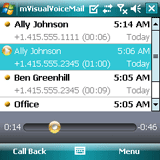 In order for the system to function properly, you must select the email account in which you would like your voice mail messages to appear. Then you must adjust your email settings to accept complete messages, which could tend to clog up your memory. But you can always set the system to store these data on a memory card.
In order for the system to function properly, you must select the email account in which you would like your voice mail messages to appear. Then you must adjust your email settings to accept complete messages, which could tend to clog up your memory. But you can always set the system to store these data on a memory card.
If you are already a registered user for previous versions, an update will cost you $12.99, otherwise the cost is $24.95. It’s available for purchase and a trial download at http://www.motionapps.com/mvisualvoicemail/index.jsp.
If you value your time, you will want to grab this application and put it to work. I deem it a must have.
Posted by conradb212 at 04:06 PM | Comments (0)
January 15, 2008
Some Favorites from CES
As one of over 140,000 attendees at CES, I sometimes felt as if I were a lemming going along with the flow from one exhibit to another mostly in awe at the whole extravaganza. If there was any cohesive theme it had to be centered on the concept of digital integration. It was evident in the inter-connectivity of devices in lifestyle and environments for the workplace, home, and automobile.
Microsoft’s impressive exhibit illustrated the concept of interconnectivity the best with on-going presentations and exhibits illustrating the integration of their software and services. 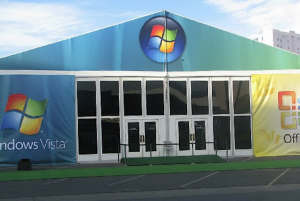
HP and other booths illustrated how digital technology can be used in every room of the house for convenience, comfort, productivity, security, and entertainment.
Many exhibitors addressed only some aspects of the integration possibilities. For instance there were many booths devoted to home security and the remote control of other home applications such as sprinklers, garage door, heating/cooling, hot tub/pool, lighting, video cameras and more. Some of the systems even integrated the use of a Windows Mobile device as a remote controller.
One entire hall was devoted to HD TV, video applications, furniture, sound, gaming, and mounting systems. With the advent of widescreen HDTV, a whole new style of furniture and interior design has emerged along with the home theater with special seating, sound systems, mounting, and connectivity considerations.
By the way, I think I’d put my money on Blu-Ray as the winner of the HD format war. Unless, by the time the dust settles, there is an entirely new format available.
There were games galore with special controllers and furniture. Judging from the cacophony coming out of some booths, the air guitars seemed to be the most popular, but that’s wandering astray from the handheld computing world--well, actually not. Hands-On Mobile of San Diego, CA, currently offers Guitar Hero Mobile.
The automobile is certainly a new focus and profit center for the integration of digital technology. Ford and Microsoft have teamed up to offer voice recognition, Bluetooth connectivity, and GPS. For several years Ford has offered Sirius satellite radio, but now it will combine MSN features such as emergency road service, live traffic and road conditions, gas prices, routing and rerouting.
The President of General Motors gave a keynote presentation indicating that GM has a few tricks up its sleeve as well. The rest of the automotive world will not be far behind.
What amuses me, however, is that all these “new” features have been part of my automobile environment for years, thanks to my trusty Windows Mobile devices with a few peripherals. But, I suppose the average person would prefer a more simple integration approach with everything already built-in.
Mobile Computing Devices
While I tried to take in everything, I’m sure I missed some nifty stuff because it was all just so overwhelming. However, I did try to focus on two things: new Windows Mobile devices and UMPCs.
I found several new WM6 devices, which I will review thoroughly as soon as I receive the evaluation units from Asus, Samsung, HP, Motorola, and Verizon. I was surprised at how few new devices were announced or released for the show. I’m not sure what HTC is doing and was never able to catch up with them, but they are getting more closed mouth now that they are working with carriers and marketing under their own name. Definite picks for best new releases include the Motorola Q9h, the Samsung shi760, and a new powerhouse iPaq Windows Mobile 6 classic release.
Since my article on UMPCs when they first emerged a couple of years ago, I have been watching to see if they would survive. While they have not and will not replace the Pocket PC, they have certainly established a respectable niche in the market. I was delighted to see several new models available.
I will be receiving units from Samsung and Asus for review and will share my findings soon. Suffice it to say for now that both companies have listened to user input and responded accordingly. You can look forward to many improvements and innovations in this evolving platform.
Apart from the big name brands such as Sony, Panasonic, and so forth, there were hundreds of booths in the Hilton and Sands venues with smaller manufacturer wannabees exhibiting some treasures, but you have to dig for them. Accordingly, I found a couple of manufacturers of great Windows Mobile devices and some really innovative UMPCs, which I hope to receive for review as well.
As for peripherals for our beloved pocket pals, I found a few gems that I will make part of my permanent pack.
Hands-Free Driving and Music
I’m always on the lookout for a good Bluetooth headset and headphones. I found both at the Jabra booth. My favorite is the Jabra BT8030 Bluetooth speaker and headphones. 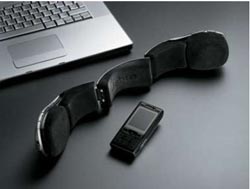 This is a first-time combination that is unique of the market. You can remove the headphones, fold them out, and they become speakers that broadcast your sound with Ziree Power Bass for a surprisingly full, rich sound environment. These are a must have in my mobile pack.
This is a first-time combination that is unique of the market. You can remove the headphones, fold them out, and they become speakers that broadcast your sound with Ziree Power Bass for a surprisingly full, rich sound environment. These are a must have in my mobile pack.
My only criticism of this otherwise brilliant product is that you cannot charge it via a USB connection. However, you can expect up to 32 hours listening time on a single charge and up to 600 hours standby time. They weigh just under 11 ounces. The suggested retail price is $250, but shop around and you can probably do better.
I’m always on the lookout for a comfortable BT headset that won’t fall out of my ear that is lightweight and not too ugly. 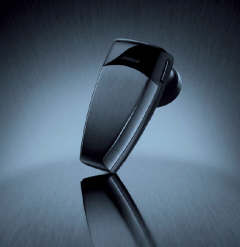 Jabra came to the rescue again with its new JX20 Pura, an elegantly crafted tiny titanium headset designed by Jacob Jensen the renowned Danish designer. It weighs less than a bird’s beak so that you don’t even know it’s there. You can listen to music with it too when you’re not talking on the phone.
Jabra came to the rescue again with its new JX20 Pura, an elegantly crafted tiny titanium headset designed by Jacob Jensen the renowned Danish designer. It weighs less than a bird’s beak so that you don’t even know it’s there. You can listen to music with it too when you’re not talking on the phone.
Its charging cradle is a work of art that will grace your desktop too. You can expect up to six hours talk time, and it can be charged in your car or via USB as well as AC. The sound quality is superb, and there is an automatic volume control.
This classy device will set you back as much as $179, which is a bit steep considering that you can buy a Bluetooth headset now for as little as $30, but you get what you pay for.
Mobile Video Just Got Better
One of my all-time favorite applications is getting better and better. I can’t imagine life without my Slingbox and SlingPlayer for my Windows Mobile devices which allows me to view my favorite live and recorded TV shows anywhere in the world with no monthly fees.
The reason I say it just got better is that with the newly released Pro-HD; you can watch full HD streaming and access multiple video sources. You can use it to stream HD video around your house to a desktop or laptop too. SlingCatcher will be coming soon, and it will make it possible to access your home video output from any video site on the Internet.
SlingPlayer 2.0 now comes with Clip+Sling, an application that allows you to record and send snips of videos, which is fun and extremely useful. Congratulations to SlingMedia for being one of the truly innovative companies in the digital universe.
Video Eyewear
I have a another pick for CES favorite—MyVu.com, which is a video viewing solution for portable devices. While this company seems hung up on iPods, it also offers a universal viewer that is supposed to work with all video output portable devices. 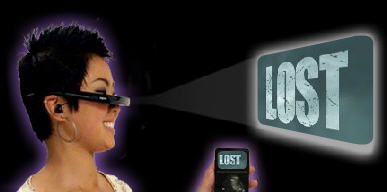 What you get for $199 is a pair of glasses that projects video output as if you were viewing it on a 27 inch screen. It’s a wonderful concept, but I’m not certain yet just what you can project. It was such pandemonium in the booth that I couldn’t get any satisfactory answers.
What you get for $199 is a pair of glasses that projects video output as if you were viewing it on a 27 inch screen. It’s a wonderful concept, but I’m not certain yet just what you can project. It was such pandemonium in the booth that I couldn’t get any satisfactory answers.
My viewing experience was that the image seemed small, isolated, non-involving, and low resolution. It could be that the game I was watching was not up to par as far as output is concerned, but what I saw left something to be desired.
Now, if you could view the output screen of your Windows Mobile device and anything that it displays in the same resolution that appears in the palm of your hand, this would be a worthwhile gadget indeed.
My.Vu offers the Crystal 701, which is an elegant hand-free viewing eyeware device with earbuds and VGA resolution and a USB rechargeable battery with up to 4 hours viewing time.
There is also the shades 301 model with sunshades and up to 10 hours viewing time. You can also get the Edge301, which is a more compact design for hands-free viewing with earbuds and a 4 hour rechargeable battery. Check it out at www. myvu.com.
As I progressed through the show, I noticed that there were other similar devices. In fact, there are many competitors in this market, but none as established as MyVu. Another competitor that seemed a good solution is Vuzix, a company that produces consumer video eyewear, medical devices, and tactical display-ware for the military.
The VR920 device simulates a 62” viewing screen but costs $399.95. The ultimate model costs $999.00. What a great way to enhance the mini screen on your handheld device. Clearly, this is a winning application that extends the limitations of Windows Mobile device small screens.
Mobile Scanning and Printing
I recently submitted an article to Smartphone and Pocket PC magazine on some of the tools I recommend for mobile productivity. I mentioned a portable scanner and printer that I try to avoid toting unless I know for certain I will need them. That was before CES and my discovery of an incredible pair of products from PlanOn with its DocuPen and petite printer.

I almost passed this booth as I had my eye on a fancy robot down the aisle when an attractive woman asked me if I had ever heard of a DocuPen. She was waving what might be a high-tech wand at me that Harry Potter would be proud to possess. It looked like a somewhat oversized ball point pen.
The demonstration blew me away, for all you have to do is wave it over any document or graphic, and it will record it in black and white, grayscale, or 24-bit full color.
It comes with PaperPort scanning software, weighs 1.75 ounces, runs on rechargeable lithium Ion batteries and features a micro-SD expansion card for additional storage. A Universal Mobile Charger accessory is good for up to 55 charges when a power source is not available.
Pair the DocuPen with the PS900 Printstik via Bluetooth, and you have a powerful mobile solution. Of course you can also transmit a scanned image to your Windows Mobile device if you wish to use it in a PowerPoint presentation or email it. Of course, you can print images already in your mobile device too.

The PrintStick is a mere 1” x 1.9” x 11” and weighs 1.9 pounds including the thermal paper and cartridge. It prints up to 3 pages per minute on 8.5” wide sheets. A cartridge will print 20 8.5 x 11 inches pages. Power options include AC 120-240, DC 12/24V, and rechargeable Lithium-ion battery.
The suggested retail price is $299 for each unit. Accessories are extra. In any case, this winning combination could be worth its weight in gold on the road in emergency situations. I’m glad that lady waived her wand at me and that I didn’t turn into a pumpkin. Check it out at www.planon.com.
MagicJack
I have one more amazing little device to share with you that impressed me even though it is not exactly in the handheld realm. It’s the MagicJack, a unique VoIP solution. 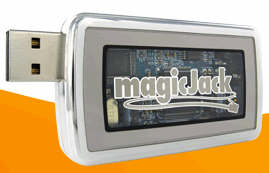 We’ve all heard of Vonage and Skype no doubt, but along comes MagicJack with a totally new approach to VoIP. Imagine a little box about the size of a pack of strike anywhere matches with a USB male plug extending from it.
We’ve all heard of Vonage and Skype no doubt, but along comes MagicJack with a totally new approach to VoIP. Imagine a little box about the size of a pack of strike anywhere matches with a USB male plug extending from it.
Just plug it into any PC USB jack, plug a regular analog phone into the other end, and start talking. Local and long distance calls are free. This phone system has all the bells and whistles you would expect from an expensive landline account such as voice mail, call waiting, and caller ID. It even has call forwarding so that you can forward calls to your mobile phone, which justifies its inclusion in this article, I suppose.
The only cost involved is to buy the device for $39.95, which includes the first year’s service. With each account, you get an actual phone number that people can call in the normal fashion with any phone from anywhere. Thereafter, it’s $19.95 per year, not per month, per year. Never pay the phone company again!
Keep connected
Posted by conradb212 at 12:40 AM | Comments (0)
January 05, 2008
How to Customize SPB Mobile Shell
You have no doubt heard the aphorism “be careful what you wish for because you just may get it.” Well, my first encounter with SPB Mobile Shell (SMS) was as a pre-installed bonus on a Pharos 600 GPS unit. I became an instant SMS enthusiast, but it left me wishing that I could have some control over customizing it to suit my own needs. For me, it was a major flaw in an otherwise super program.
Recently I acquired a new WM6 device without SMS, so I installed the latest version and soon discovered that it was indeed customizable at last.
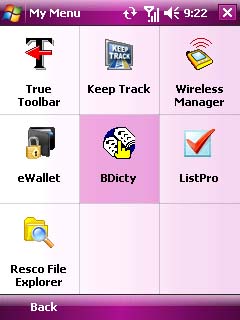
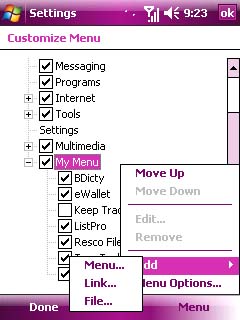 In case you are not familiar with SMS yet, let me introduce you. SMS is a brilliant application that makes access to the depths of your device easy with big, finger-friendly icons and a nice flash screen that displays the time, date, upcoming appointments, weather, number of new messages, battery life, and phone mode. Tap on the SPB Menu soft or hard button and nine big icons appear that let you quickly navigate to tools, messaging, settings, organizers, start, programs, multimedia, Internet, or my menu.
In case you are not familiar with SMS yet, let me introduce you. SMS is a brilliant application that makes access to the depths of your device easy with big, finger-friendly icons and a nice flash screen that displays the time, date, upcoming appointments, weather, number of new messages, battery life, and phone mode. Tap on the SPB Menu soft or hard button and nine big icons appear that let you quickly navigate to tools, messaging, settings, organizers, start, programs, multimedia, Internet, or my menu.
The My Menu button was a new one that did not appear previously. When I tapped on it, it brought up an empty screen. Curious, I started to poke around in settings where I discovered another new button called Customize Menu. Tapping on it brought up a list of all the buttons with check boxes previously mentioned above. If the box is checked, the button appears on the SPB Menu screen. I then discovered that if you highlight a particular heading, click on menu, and select Add, you can start adding (or removing) content in the form of links and files.
This is just what I had been wishing for, because now I could completely customize the content of any SMS button by adding or subtracting files and program links. If you tap on More Options, you can choose to have the content displayed in a list or grid format. You can also select whether you want the items to be displayed in the order of their frequency of use or optimized for hardware navigation.
Be certain that you highlight the button title, not the content title or the add feature will not work. Obviously, you cannot add content to sub-headings. You can edit the file location and change the icon of a sub-heading item though.
A more roundabout way to access the customization functionality is to go to Start, Settings, System, SPB Mobile Shell, and select the Advanced tab. On the Advanced screen, tap Menu, and you will be in the place described above with the list of buttons. You can also customize the Now or opening flash screen with any plug-ins you may have from SPB software such as SPB Diary or PhoneSuite.
While I am delighted with the customization feature, I still have a wish list for future iterations. In addition to being able to add files and program links, it would be nice to add Internet hyperlinks. I suppose one could argue, however, that this feature is already subsumed in the Internet favorites folder to some extent. It would also be nice if you could add content to sub-folders for better organization. Oh well, thank God for evolution. But, for the most part, my wish did come true.
Posted by conradb212 at 07:06 PM | Comments (0)
January 03, 2008
Whether you like it or not…
The weather affects us all, whether we like it or not. Sometimes it can be a matter of life or death, so it’s an undeniably important aspect of your life. As long as you pack a digital device in your pocket, you may as well have a weather report on your Today screen for easy access.
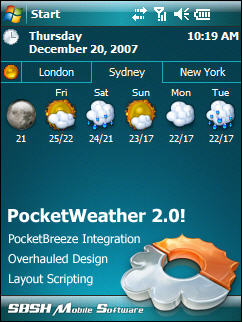 As far as I’m concerned, the best weather application is, and always has been, hands down, no contest, no discussion needed, PocketWeather by SBSH Softwarehouse. It simply has the most comprehensive weather info, the largest database of cities with the easiest retrieval among all competitors.
As far as I’m concerned, the best weather application is, and always has been, hands down, no contest, no discussion needed, PocketWeather by SBSH Softwarehouse. It simply has the most comprehensive weather info, the largest database of cities with the easiest retrieval among all competitors.
The good news is that it just got better with a brand new 2.0 release.
Some of the new features include a whole redesign of the Today screen with tabs, icons, and layout scripting so that you can customize it to your own specifications.
If you like to pack a lot of information on your Today screen for instant gratification, you should consider integrating PocketWeather with the latest version of PocketBreeze, another SBSH product that makes your Outlook info efficiently viewable and available.
As I am getting ready to take off for Las Vegas and CES, I do not have time to go into all the detail these products deserve. I mainly wanted to endorse them and make readers aware of the new release. Registered users can upgrade for only $4.95. Otherwise you can bundle both products for just $14.90. For more information, go to http://www.sbsh.net/products/pocketweather.
Posted by conradb212 at 01:36 PM | Comments (0)
